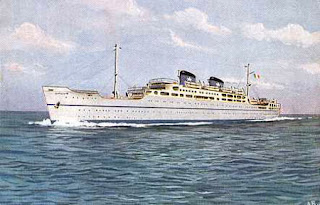Sorrentine businessman once dubbed the ‘Neapolitan Onassis’
 |
| Achille Lauro built a hugely successful commercial fleet |
Lauro also served as Mayor of Naples for six years in the 1950s and again, briefly, in the 1960s. While in office, he oversaw the building of the Stadio San Paolo football stadium - home of SSC Napoli football club - and the city’s Piazza Garibaldi railway station among other projects.
Born in what was then the fishing village of Piano di Sorrento on 16 June, 1887, Achille learned about the boat-building industry at an early age. His father, Gioacchino, owned a number of vessels.
It was always likely that Achille would become part of the family business. His father insisted he spent some time on the high seas working on one of his ships in order to toughen up and after primary school he was sent to the Nino Bixio Nautical Institute in Piano.
In the event, responsibility came early to Achille and in tragic circumstances. When he was only 20, Gioacchino died. Having earlier lost two of his brothers in a shipwreck, Achille was the senior member of the family and thus inherited the business.
He operated his father’s small fleet but lost all of his ships at the start of the First World War, when they were requisitioned by the government. When the conflict ended he had no money but managed to launch another fleet by creating a company that was part-owned by its employees, who invested their savings in return for a share of the profits and a guarantee of employment.
 |
| Lauro named his first passenger liner the MS Surriento, after the Neapolitan dialect name for Sorrento |
Again, his entire fleet was requisitioned by the state, but as a member of the Fascist party since 1933 Lauro was fully supportive of Mussolini, who compensated him by giving him 50 per cent of all Naples newspapers, which had previously been state controlled.
His support for the Fascists became known to the Allies and when Italy surrendered in 1943 he was arrested as a collaborator and spent 22 months in jail. Ultimately he was cleared of any criminal activity and allowed to resume his business, albeit with a fleet reduced to just five boats.
Ever the astute operator, however, he snapped up passenger vessels being sold off by the American military and capitalised on the mass migration of Italians to South America and Australia.
By the early 1950s, the Lauro line’s complement of ships was already back up to 50, re-establishing his position as the Mediterranean’s biggest shipping company. Known often as 'Il Comandante', he was also dubbed 'the Neapolitan Onassis' after the Greek shipping tycoon.
Lauro entered politics in 1952 when he stood for Mayor of Naples as a member of the Monarchist National Party, a political group that had continued to win support despite Italy’s rejection of the monarchy in favour of a republic after World War Two.
 |
| Piazza Angelina Lauro in Sorrento, opposite the railway station, is named after Achille Lauro's first wife |
Lauro moved into national politics after he had been ousted as Naples mayor in 1958 and was elected first as a deputy and then a senator in the Italian parliament.
Flotta Lauro hit the rocks financially due to the effects of the international oil crisis in the 1970s. In an effort to keep going, Lauro sold scores of business and personal assets, including his house in the heart of Naples, his luxurious villa near Massa Lubrense on the Sorrento peninsula, plus much of his collection of paintings, silverware, Capo di Monte porcelain and antique furniture, including a billiard table said to have belonged to Admiral Nelson.
When Lauro died, aged 95, in November 1982, the fleet was broken up and sold. His popularity was such that thousands of Neapolitans turned out for his funeral. In Sorrento, his name is commemorated in Piazza Angelina Lauro, named after his first wife. There is a bust of Achille in the square.
Home
No comments:
Post a Comment